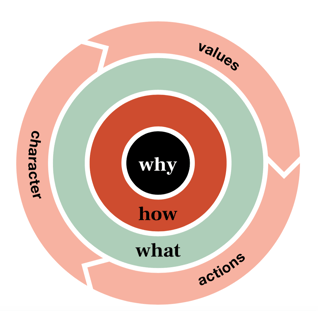Written by
Catherine Clark
When the concept of tomorrow changes every day, preparing your brand for what’s next can feel like taking a shot in the dark. For 20 years, we’ve been in the business of creating, growing and transforming brands to be future-ready, but never in those two decades has being prepared for what lies ahead been so urgent.
Brands must be thinking ten steps ahead: preparing to succeed not only in today’s reality but tomorrow’s as well. In the wake of the pandemic, we’ve partnered with countless brands to find a way forward—from rebranding some of America’s most loved icons to creating mobility experiences that will forever change your time in the car.
Change can get uncomfortable, but it can also create opportunity for ideas, innovation and growth. While being future-ready means something different to every brand, we’ve found these four fundamentals are beneficial to all who adopt them.
Lead with purpose
The role of purpose has taken greater importance in recent years—and even more so in the wake of the pandemic. We’re all navigating uncertain times and looking for brands we trust, with values that connect to ours, to hold onto. 
To lead authentically, brands need to rally behind their “why” and their “how.” Why does your brand exist? What purpose unites the real people behind it? How do you uniquely do things? When this is clear, decision-making becomes more intentional, and inevitable challenges are easier to overcome—creating greater resilience and optimism.
Take the Oklahoma City Thunder, for example. As the pandemic completely upended the world of professional sports, from suspended seasons to virtual spectating, adapting to new rules and navigating unprecedented challenges became a regular routine.  We’ve had the privilege of witnessing firsthand how a powerful vision has made this forward thinking NBA organization intrinsically ready for the future. Their entire team is committed to pursuing progress, relentlessly, in everything they do. With absolute clarity on their true character and reason for being, they rally together as they build their unique legacy—creating deep love and enduring engagement from their talent, community and fans.
We’ve had the privilege of witnessing firsthand how a powerful vision has made this forward thinking NBA organization intrinsically ready for the future. Their entire team is committed to pursuing progress, relentlessly, in everything they do. With absolute clarity on their true character and reason for being, they rally together as they build their unique legacy—creating deep love and enduring engagement from their talent, community and fans.
When purpose is successful, it creates a force for change that emanates from within the organization. What change is your brand capable of creating? When your values become an intrinsic part of the experience, you become bigger than the sum of your parts. You may be surprised by what you can spark.
Put Digital at the Core, Always
Digital has been part of the brand ecosystem for quite some time. But it’s no longer just a medium: in the same way social media, apps, and content have become woven into the fabric of our lives, they’re now an omnipresent part of the brand experience. Even retail giants like Walmart, who traditionally may have seen online shopping as a threat to their business, are reshaping the in-store shopping experience by putting digital at the forefront, as are brands in sectors like hospitality that rely heavily on the in-person experience. Airbnb shows us how to build an experience across platforms—from a wanderlust-inspiring YouTube channel to a community-driven onsite storytelling space.
Even retail giants like Walmart, who traditionally may have seen online shopping as a threat to their business, are reshaping the in-store shopping experience by putting digital at the forefront, as are brands in sectors like hospitality that rely heavily on the in-person experience. Airbnb shows us how to build an experience across platforms—from a wanderlust-inspiring YouTube channel to a community-driven onsite storytelling space.
It’s essential to embed digital thinking into your process from the beginning—not tack it on as an afterthought. In the days ahead, you’ll need internal members and external partners who truly integrate digital with strategy, innovation, storytelling...and who can connect creativity with data.
Be Responsive
Today’s brands need to be built with agility: there’s no set-it-and-forget-it in an unpredictable world. The brands with staying power aren’t the ones that think they have all the answers, but the ones who prepare themselves to respond. It’s up to leaders to put foundations in place that allow their organizations to make decisions deftly and iterate around the customer. Being responsive means acknowledging there’s no such thing as perfection and committing to constant improvement. Brave brands will take the leap from a business-led approach to a consumer-led strategy, leaving a seat at the table for audiences to inform when and how to adapt.
Being responsive means acknowledging there’s no such thing as perfection and committing to constant improvement. Brave brands will take the leap from a business-led approach to a consumer-led strategy, leaving a seat at the table for audiences to inform when and how to adapt.
Brands like Glossier have flung the door wide open for consumers by crowdsourcing product ideas right from their customers’ comments. It’s not an approach that every business can adopt, but we encourage all leaders to think like entrepreneurs, acknowledging the needs consumers have and the power they hold.
Being responsive to audiences means accepting change as an inevitability. If your brand looks different two years from now, that’s not failure—that’s evolution.
Focus on Community
Building a brand has always been predicated on offering an experience, not just a product. Now, several months into various stages of lockdown, that experience we’re craving is a sense of togetherness.
We’ve witnessed the success of brands like Peloton that are built around access to a group of like-minded people. But for businesses whose foundation isn’t human connection, opportunities still exist to innovate around community.
Harman, a Samsung Company, keyed into this to flip the dialogue with car manufacturers. A leader in connected mobility experiences, Harman is delivering on a promise to make time in your car, time well spent. One way they’re achieving this is by allowing customers to turn their cars into a live concert venue, shifting the conversation to how humans connect around music instead of letting tech and features dominate the narrative.
Access to a community will always be more valuable than a product alone. Brands that offer connection will not only boost their worth in the short-term, they’ll build a buzz that will last long after we’re gathering together again.
From the Inside Out
It’s tempting for brands to take a keeping-up-with-the-Joneses approach to evolution, relying on external forces to determine what move to make next. But true resilience comes from internal shifts.
When your brand becomes clear on what it stands for, where its priorities lie, and how it defines its relationship with its consumers, you’ll find the answers to most challenges emerge with far less effort. This kind of future-proofing empowers brands to stop shirking from the unknown and stride boldly towards it.
Interested in hearing more? Follow us on LinkedIn and subscribe for our newsletter.
Sign up for the latest news and views
